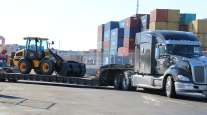Staff Reporter
Coronavirus Likely Altered Supply Chains Permanently, XPO’s Chowdhury Says

[Ensure you have all the info you need in these unprecedented times. Subscribe now.]
Supply chains have changed dramatically to adapt to the coronavirus, but many of those changes may outlast the pandemic.
“This has been a very interesting year,” said Ashfaque Chowdhury, XPO Logistics president of supply chain for the Americas and Asia Pacific. “There’s been lots of changes and lots of unexpected challenges throughout the year, but also lots of learning opportunities and outlooks moving forward that are very different than one would have expected even in January of this year.”
Chowdhury spoke during a webinar hosted by the Massachusetts Institute of Technology. The four-part series primarily has focused on manufacturing. XPO partnered with the school as part of the MIT Industrial Liaison Program.
Join us for a #webinar on #manufacturing on Tuesday, Dec.1st at 11:00 AM ET featuring @mitsupplychain's @josue_logistics and @XPOLogistics Ashfaque Chowdhury.
Learn more https://t.co/B8U4BDdOgP and register https://t.co/Z7U3mCUEtF pic.twitter.com/s8nfxf6D2U — MIT ILP (@mit_ilp) November 25, 2020
“The impact of COVID has been dramatic in how we operate today and how it has changed our workplace,” Chowdhury said. “But my proposition is that this is not necessarily going to go back to just the way it was. We may be able to relax after the response from the medical community with the vaccines and other things.
“But there has been some fundamental changes in trends and how the world works, and how supply chains work is actually different. Our industry needs to have strategies to be able to adapt to these new trends.”
Chowdhury highlighted short-term changes such as truckload rates being up and companies implementing health and safety protocols to limit the spread of the coronavirus. But he also focused on trends that likely are here to stay such as warehouses accelerating the use of robotics, more business consolidation and a huge jump in e-commerce.
When we distribute products with e-commerce, it takes much less labor in the sales part of the process because it’s online, and you don’t have store associates, but it takes a lot more work in the warehouses.
Ashfaque Chowdhury, XPO Logistics president of supply chain for the Americas and Asia Pacific
“We have had a one-time effect that is a dramatic acceleration of the use of e-commerce that we don’t expect will go back,” Chowdhury said. “This dramatic shift means e-commerce essentially went from 15% to 25%. So a very big change in the amount of goods sold with e-commerce.”
Chowdhury noted e-commerce hit a peak this year that should have taken another three or five years based on spending trends pre-pandemic. His data showed that e-commerce went from 15% of all retail sales last year to a projected 25% in 2021.
“When we distribute products with e-commerce, it takes much less labor in the sales part of the process because it’s online, and you don’t have store associates, but it takes a lot more work in the warehouses,” Chowdhury said. “This change means there is a dramatic additional need for space and work within the fulfillment side in order to cope with this surge in demand. Our research shows this consumer behavior shift is sustained.”
XPO conducted a survey asking consumers how likely they are to keep buying things online that before the pandemic, they would have gone to the store for. The survey found people are more willing to keep buying many products online that they didn’t before such as groceries, cleaning supplies and apparel.
“There is nothing that makes us see that demand is going to go down anytime soon,” Chowdhury said. “As next year comes around, there is not a great deal of additional population density in these markets to see a surge of additional labor availability. So these patterns are challenges that are really our new normal and we need to solve.”
Chowdhury added that the supply chain sectors could see more consolidation. There likely will be fewer small operations since the increase in automation and scale of logistics seems to favor larger firms. Both trends have grown as a result of the pandemic.
“Increasingly more sophisticated solutions are necessary in order to reach the capabilities and velocities, and in order to do that there are significant investments that are necessary in terms of technologies and facilities,” Chowdhury said. “I do think that will create more opportunities for larger companies to provide a portion of that capability.”
Chowdhury noted the connected economy, which includes firms such as Uber Freight, also might create emerging opportunities and marketplaces that will favor smaller logistics firms. He also indicated there has been an increase in warehouse workers despite high unemployment this year.
“Even though unemployment levels are double year-over-year, we would have expected the employment levels in warehouses to dip,” Chowdhury said. “But it didn’t. The employment levels in warehouses are now up 6% year-over-year. This means we have a very high increasing demand by the consumer and a shortage of supply of labor within the warehouses to meet that demand.”
XPO ranks No. 3 on the Transport Topics Top 100 list of the largest for-hire carriers in North America. It ranks No. 1 on the Transport Topics Top 50 list of the largest logistics companies.
Want more news? Listen to today's daily briefing:
Subscribe: Apple Podcasts | Spotify | Amazon Alexa | Google Assistant | More





